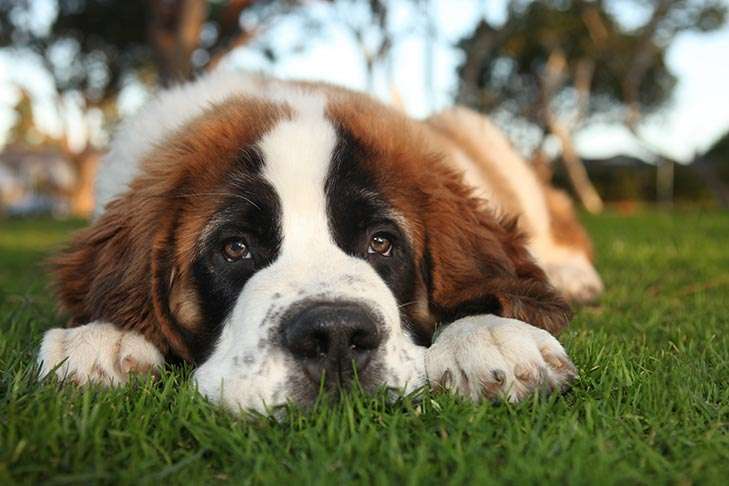Stress is a commonly used word that describes feelings of strain or pressure. The causes of stress are exceedingly varied. Perhaps you are stressed out by your job, you become nervous when meeting new people, or you get anxious when your daily routine is disrupted.
To reduce stress levels, you may seek comfort in several ways. Maybe you find solace in the company of a trusted friend. Perhaps you relieve stress when occupied by routine chores like cleaning the house. Or maybe you blow off some steam with physical exercise.
“Our dogs can become stressed too.”
Our dogs can become stressed too. Since we know how stress makes us feel, we certainly want to help alleviate our pet’s stress as well. However, our dogs do not voice their feelings, slam down the phone, or have a tantrum, so how can we tell they are stressed? The signs of anxiety in dogs are often subtle. In fact, some stress-related behaviors mimic normal behaviors.
What are some of the indicators of stress in dogs?
Pacing or shaking. You have seen your dog shake after a bath or a roll in the grass. That whole body shake can be amusing and is quite normal…unless it is occurring as the result of a stressful situation. For example, dogs are commonly stressed when visiting the veterinarian. Many dogs “shake it off” when they descend from the exam table and touch down on the ground. Dogs, like people, also pace when agitated. Some dogs walk a repeated path around the exam room while waiting for the veterinarian to come in.
Whining or barking. Vocalization is normal self-expression in dogs but may be intensified when they are under stress. Dogs that are afraid or tense may whine or bark to get your attention, or to self soothe.
Yawning, drooling, and licking. Dogs yawn when they are tired or bored, they also yawn when stressed. A stressful yawn is more prolonged and intense than a sleepy yawn. Dogs may also drool and lick excessively when nervous.
Changes in eyes and ears. Stressed dogs, like stressed people, may have dilated pupils and blink rapidly. They may open their eyes really wide and show more sclera (white) than usual, giving them a startled appearance. Ears that are usually relaxed or alert are pinned back against the head.
Changes in body posture. Dogs normally bear even weight on all four legs. If a healthy dog with no orthopedic problems shifts his weight to his rear legs or cowers, he may be exhibiting stress. When scared, dogs may also tuck their tails or become quite rigid.
Shedding. Show dogs that become nervous in the show ring often “blow their coat”. Dogs also shed a lot when in the veterinary clinic. Although less noticeable in outside settings, such as visiting a new dog park, shedding increases when a dog is anxious.
Panting. Dogs pant when hot, excited, or stressed. If your dog is panting even though he has not exercised, he may be experiencing stress.
Changes in bodily functions. Like people, nervous dogs can feel a sudden urge to go to the bathroom. When your dog urinates shortly after meeting a new canine friend, he may be marking territory and reacting to the strain simultaneously. Refusal of food and loss of bowel function are also stress indicators.
Avoidance or displacement behavior. When faced with an unwelcome situation, dogs may “escape” by focusing on something else. They may sniff the ground, lick their genitals, or simply turn away. Ignoring someone may not be polite, but it is surely better than being aggressive. If your dog avoids interaction with other dogs or people, do not force the issue. Respect his choice.
Hiding or escape behavior. An extension of avoidance, some tense dogs literally move behind their owners to hide. They may even nudge their owners to prompt them to move along. As a means of escape, they may engage in diversion activities such as digging or circling or may slink behind a tree or parked car.
How can I help my dog handle stressful situations?
In order to differentiate stress signs from normal behavior, you must be familiar with your dog’s regular demeanor. Then you can tell if he is licking his lips because he is anxious or because he wants a treat.
When relaxed, he will have semi-erect or forward-facing ears, a soft mouth, and round eyes. He will distribute his weight evenly on all four paws. Distinguishing normal behavior from stress signs will help you quickly and effectively diffuse an uncomfortable situation.
“If your dog is stressed, first remove him from the stressor.”
If your dog is stressed, first remove him from the stressor. Find a quiet place for him to regroup. Resist the urge to overly comfort him. If you want to pamper him with petting or treats, make him earn them first by performing an activity (e.g., sitting). Responding to routine commands distracts the dog and provides a sense of normalcy. It is amazing how comforting sit, down, and heel can be to a worried dog.
If your dog becomes consistently stressed, see your veterinarian. After ensuring that your dog’s behavior does not have a medical basis, your veterinarian may refer you to a trainer or veterinary behaviorist to evaluate stress-related issues. They may also prescribe anxiety-reducing medications if appropriate.
As with humans, exercise can be a great stress reducer. Physical activities like walking or playing fetch help both you and your dog release tension. It is also good to provide your dog with a safe place in the home where he can escape anxious situations. Everybody enjoys a calm place to retreat.
And, finally, remember that stress is not always bad. Fear is a stress-related emotion that prompts us to avoid potentially dangerous situations. So, stress may actually be a protector. Regardless, stress is part of everyday life for us and our dogs, so we should learn how best to deal with it.
Just like humans, dogs experience anxiety. While unpleasant, it is a normal and also healthy emotion. Dog anxiety can affect all breeds, but may affect each individual dog differently. Although it is something that all dogs experience from time-to-time, if disproportionate levels of anxiety are left unchecked, a dog can develop an anxiety disorder. If left untreated, dog anxiety can lead to behavioral and other issues.
How do you know if your dog has anxiety? What can you do to treat dog anxiety? We’re here to explain everything you need to know about dog anxiety — common causes, symptoms, and treatments. Additionally, we’ll discuss top tips for anxiety prevention. This way, if your dog ever does suffer from anxiety — you’ll have all the knowledge you need as an owner to help.
Dog Anxiety: Causes
According to the Merck Veterinary Manual, dog anxiety can have a variety of causes. Some of the most common causes of dog anxiety are:
- Fear
- Separation
- Aging
Fear-related anxiety can be caused by loud noises, strange people or animals, visual stimuli like hats or umbrellas, new or strange environments, specific situations — like the vet’s office or car rides — or surfaces like grass or wood floors. Although some dogs may only have brief reactions to these kind of stimuli, they may affect anxious dogs more consequentially.
Separation anxiety is estimated to affect around 14 percent of dogs. Dogs with separation anxiety are unable to find comfort when they are left alone or separated from their family members. This anxiety often manifests itself in undesirable behaviors, such as urinating and defecating in the house, destroying furniture and furnishings, and barking.
Age-related anxiety affects older dogs and can be associated with cognitive dysfunction syndrome (CDS). In dogs with CDS, memory, learning, perception, and awareness start to decline, similar to the early stages of Alzheimer’s disease in humans. This understandably leads to confusion and anxiety in senior dogs.
Dog Anxiety: Symptoms
So how can you tell if your dog has anxiety? There are several important symptoms to look out for:
- Aggression
- Urinating or defecating in the house
- Drooling
- Panting
- Destructive behavior
- Depression
- Excessive barking
- Pacing
- Restlessness
- Repetitive or compulsive behaviors
Some of these symptoms may be the result of occasional anxiety-causing events, but any of these can become recurrent and therefore, result in more serious issues. This being said, by far the most dangerous symptom of dog anxiety is aggression. This aggression can be targeted directly or indirectly, depending on the situation. Direct aggression occurs when a dog acts aggressively toward people or other animals. Indirect aggression can be equally dangerous, and often happens when a person comes between the dog and the source of the dog’s aggression, such as another dog. Even if a dog is prevented from harming others, aggressive behaviors such as growling or barking can lead to undesirable situations for humans and dogs, alike.
Urinating and defecating in the house is a common symptom of separation anxiety. Anxious dogs often work themselves up to the point that they pee or poop in the house, even if they are housebroken. This is frustrating for owners and can cause damage to property, not to mention the unpleasantness of the cleanup.
Destructive behavior is also common with separation anxiety. The damage is usually located around entry and exit points, like doorways and windows, but dogs in a state of heightened anxiety are also at risk of harming themselves. Attempts to break out of dog crates, windows, and even doors can result in painful injuries and expensive veterinary treatments.


Dog Anxiety: Treatment
The best way to treat anxiety is to talk with your veterinarian. Your veterinarian can help you identify the type of anxiety your dog suffers from and the possible causes and triggers. Your veterinarian will also be able to help you determine if the anxiety is simply situational, or if it is becoming an overwhelming issue for your dog. Additionally, veterinarians can also rule out any other medical conditions that could be causing your dog’s symptoms.
Your veterinarian will help you come up with a treatment plan. Since excessive anxiety is often caused by a variety of factors, the best way to treat it is usually through a combination of training, preventive strategies, and in some cases, medications.
Training and Counterconditioning
There are several training strategies owners can use to treat dog anxiety. One way is counterconditioning. The purpose of counterconditioning is to change your dog’s response to the stimuli responsible for anxiety, usually by replacing the anxious or aggressive behavior with a more desirable behavior, like sitting or focusing on the owner.
Another training strategy is desensitization. The owner slowly introduces the dog to the source of anxiety, preferably in small doses and at a decreased intensity. Repeated exposure and rewarding positive behavior can go a long way toward managing anxiety.
You might want to contact a professional dog trainer to help you choose the best approach for your dog, as training an anxious dog is not always easy.
Anxiety Medications for Dogs
If your dog develops a serious anxiety disorder, your veterinarian may recommend medications or natural therapies. SSRIs and antidepressants are occasionally prescribed for dogs with anxiety, including fluoxetine and clomipramine. For predictable anxiety-producing events like thunderstorms, fireworks, or car rides, your veterinarian might prescribe a medication such as benzodiazepine in conjunction with an antidepressant to help your dog cope with the stress.
Senior dogs with cognitive dysfunction syndrome may benefit from the drug selegiline, which can help reduce some of the symptoms of CDS. Selegiline is also used for treating chronic anxiety in Europe.
The Merck Veterinary Manual also states that natural therapies and products can help dogs with anxiety. Some products work best in conjunction with other medications, while others can be used alone, depending on your dog’s case. Natural products use pheromones and aromatherapy to reduce anxiety. Talk to your veterinarian about the natural products best suited for your dog.
Using CBD Oil for Dog Anxiety
Some dogs owners have reported success in using CBD oil to treat dog anxiety. CBD is a compound found in cannabis and hemp that dog owners, as well as humans, have found useful for treating a variety of different health conditions. Anecdotal reports from dog owners claim that CBD oil can be effective in treating dog anxiety.
It’s important to note, however, that although many humans use CBD oil for anxiety treatment purposes, there is currently no scientific data on how using CBD oil affects dogs. Additionally, CBD products are not yet regulated — meaning consistency and purity are not always validated. Therefore, if you’re considering using CBD oil as a treatment for dog anxiety, it’s best to consult with your veterinarian. Your veterinarian can help you determine if CBD oil might be a good treatment for your dog’s anxiety, as well as discuss different products, possible side effects, and risks.
Learn about the CBD oil study being conducted by the AKC Canine Health Foundation.


Dog Anxiety: Prevention
It can be difficult to predict exactly what will make your dog anxious, and even more difficult to determine if your dog’s anxiety will develop into a more serious disorder. However, there are ways to help a dog or puppy avoid anxiety-related problems.
Body Language
One of the best things you can do is learn to read dog body language. Knowing when your dog is uncomfortable or scared can help you avoid negative experiences or use them as a positive training moment. Body language can also tell you when a dog is getting anxious, which is especially useful if your dog has a history of aggression-related anxiety.
Socialization
Proper socialization can prevent the development of anxiety. Introducing your dog to new people, dogs, animals, places, and experiences can help avoid an exaggerated response down the road, and also helps your dog become a well-adjusted canine citizen.
Obedience
Obedience training is an essential tool for preventing and managing dog anxiety. It lays the foundation of a healthy relationship and establishes trust. A well-trained dog is easier to socialize than a dog without training, and obedience classes are a great place for dogs to meet other dogs in a controlled environment.
Exercise and Nutrition
Regular exercise and stimulation are crucial for a dog’s development, physical, and mental well-being. A stimulated dog is less likely to pick up destructive behaviors, and good nutrition is equally important for your dog’s health. Making sure you take care of your dog’s physical and mental needs can help you prevent any behavior problems that don’t stem from anxiety, letting you know the areas where your dog needs the most help.
Situation Avoidance
If your dog has been diagnosed with anxiety issues, you can also try to avoid or prevent situations that trigger your dog’s anxiety. For example, if you know that your dog grows anxious around large groups of dogs, you should avoid dog parks. Avoidance does not mean that you need to put your life on hold, but it can reduce some of the stress on you and your dog.
If the source of the anxiety cannot be avoided, preventive measures like leashes, body harnesses, and, in some cases, basket muzzles, can prevent dangerous situations. Once you know your dog’s triggers, you can prepare for these situations ahead of time.
Dog Anxiety: The Bottom Line
Like humans, many dogs will experience anxiety at some point throughout their lives. Although not all dogs will have anxiety that leads to a diagnosable anxiety disorder, it’s important to know the causes, symptoms, and treatment options involved with dog anxiety. Understanding these important facets can help you, as an owner, know the best ways to help your dog in anxiety-inducing situations. If you think that your dog might have an issue with anxiety, it’s best to consult your veterinarian — your veterinarian can diagnose your dog, rule out any other health issues, and help you develop a treatment plan that best fits your dog and lifestyle.
Innovet created a product line of full spectrum pure hemp oils void of dangerous compounds. Their USDA certified organic oil is formulated especially for animals and is also third-party tested to ensure consistency and purity. Innovet offers more than 50 affordable products to help pets manage anxiety, pain, as well as other conditions. Get more information about Innovet’s CBD products.





